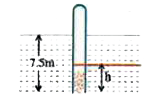What should be the volume of mercury in a glass flask of volume 150cm3, so that the volume of air in the flask may remain same at all temperatures ? (The coefficient of linear expansion of glass is 8x10−6/∘C and the coefficient of real expansion of mercury =18×10−5/∘C)
20cm3
Topper's Solved these Questions
- EXPANSION OF LIQUIDS BOOK - AAKASH SERIESCHAPTER - EXPANSION OF LIQUIDS EXERCISE - NUMERICAL (EXERCISE) (LEVEL-2)
11 Videos
- EXPANSION OF LIQUIDS BOOK - AAKASH SERIESCHAPTER - EXPANSION OF LIQUIDS EXERCISE - QUESTIONS FOR DESCRIPTIVE ANSWERS
4 Videos
- EXPANSION OF LIQUIDS BOOK - AAKASH SERIESCHAPTER - EXPANSION OF LIQUIDS EXERCISE - VERY SHORY ANSWER TYPE QUESTIONS
15 Videos
- EXPANSION OF GASESBOOK - AAKASH SERIESCHAPTER - EXPANSION OF GASESEXERCISE - QUESTIONS FOR DESCRIPTIVE ANSWERS
4 Videos
- EXPANSION OF SOLIDS BOOK - AAKASH SERIESCHAPTER - EXPANSION OF SOLIDS EXERCISE - Questions for Descriptive Answers
5 Videos
Similar Questions
A vertical glass tube closed at the bottom contains mercury to height of 50 cm at 20∘C. What will be the height of mercury column at 40∘C?(γHg(R)=18.5×10−5/∘Candαg=8×10−6/∘C)
View SolutionA specific gravity bottle weighs 24.53gm when empty and 51.03 gm when filled with a liquid at 25∘C. The bottle with the liquid at 100∘C weighs 49.53 g. Calculate the coefficient of apparent expansion of the liquid.
View SolutionWhy the expansions of the liquids is greater than the expansion of the solids ?
View SolutionA thin uniform tube of length 9 m closed at one end is immersed in water to a depth of 7.5 m. Find the height h to which water rises in the tube. Ignore any temperature change and take atmosphere pressure as 10 mg water column.

View SolutionThe length of an iron rod is measured by a brass scale. When both of them are at 20∘C, the length is 80 cm. What is the length of the rod at 100∘C as measured by the scale at 100∘C? The coefficient of linear expansion of brass and iron are 24×10−6(C∘)−1and18×10−6(C∘)−1 respectively.
View SolutionA 1-L flask contains some mercury. It is found that at different temperature, the volume of air inside the flask remains the same. What is the volume of mercury in the flask, given that the coefficient of linear expansion of glass =9xx10^(-6)//^(@)C and the coefficient of volume expansion of Hg=1.8xx10^(-4)//^(@)C ?
View SolutionA glass bulb of volume 250cc is filled with mercury at 20∘C and the temperature is raised to 100∘C. If the coefficient of linear expansion of glass is 9×10−6/∘C). Coefficient of absolute expansion of mercury is 18×10−5/∘C). The volume of mercury overflows
View Solutionthe coefficient of volume expansion of mercury is 20times the linear expansion of glass. Find the volume of mercury that must be poured in to glass vessel of volume V so that the volume above the mercury remain constant at all temperatures
View SolutionThe internal volume of a glass flask is V cm^(3) . What volume of mercury should be kept in the flask so that the volume of the empty space over mercury in the flask remains constant at all temperatures? Coefficient of volume expansion of mercury =1.8 times 10^(-4@)C^(-1) and coefficient of linear expansion of glass =9 times 10^(-6@)C^(-1).
View SolutionThe volume expansion coefficients of glass and mercury are 2.4×10−5∘C−1 and 1.8×10−4∘C−1 respectively. What volume of mercury should be kept in the flask so that the volume of the empty space over mercury in the flask remains constant at all temperatures?
View SolutionThe internal volume of a glass flask is 540cm^(3) . What volume of mercury should be kept in the flask so that the volume of the empty space remains constant at any temperature? Real expansion of mercury =1.8 times 10^(-4@)C^(-1) and volume expansion of glass =2.5 times 10^(-5@)C^(-1).
View SolutionA 1 L flask contains some mercury. It is observed that the volume of air in the flask remains unchanged at all temperatures. What is the volume of mercury in the flask? Coefficient of linear expansion of the material of the flask =9×10−6∘C−1and coefficient of real expansion of mercury =1.8×10−4∘C−1
View SolutionA glass container of volume V contains some mercury. The coefficients of cubical expansion for glass and mercury are gamma_g and gamma_m , respectively. If the volume of air inside the flask remains constant at different temperature, then the volume of mercury in the flask is
View SolutionA glass flask of volume 1 litre is fully filled with mercury at 0∘C. Both the flask and mercury are now heated to 100∘C. If the coefficient of volume expansion of mercury is 1.82×10−4/∘C, volume coefficient of linear expansion of glass is 10×10−6/∘C, the amount of mercury which overflows is
View SolutionA glass flask whose volume is exactly 1000 at 0^@C is completely filled with mercury at this temperature . When the flask and mercury are heated to 100 ^@C , it is found that 15.4 cm^3 of mercury overflows. If the coefficient of volume expansion of mercury is 1.8xx10^(-4)//K , calculate the coefficient of volume expansion of glass.
View Solution

